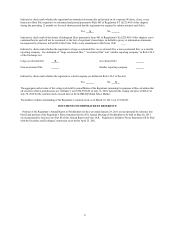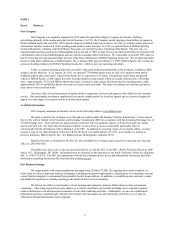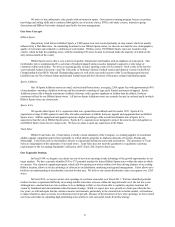Hibbett Sports 2011 Annual Report Download - page 16
Download and view the complete annual report
Please find page 16 of the 2011 Hibbett Sports annual report below. You can navigate through the pages in the report by either clicking on the pages listed below, or by using the keyword search tool below to find specific information within the annual report.12
Problems with our information system software could disrupt our operations and negatively impact our financial results and
materially adversely affect our business operations.
The efficient operation of our business is dependent on the successful integration and operation of our information
systems. In particular, we rely on our information systems to effectively manage our sales, distribution, merchandise planning
and replenishment, to process financial information and sales transactions and to optimize our overall inventory levels. We
attempt to mitigate the risk of possible business interruptions by maintaining a disaster recovery plan, which includes storing
critical business information off-site. Most of our information systems are centrally located at our headquarters, with offsite
backup at other locations. Our systems, if not functioning properly, could disrupt our ability to track, record and analyze sales
and inventory movement and could cause disruptions of operations, including, among other things, our ability to process and ship
inventory, process financial information including credit card transactions, process payrolls or vendor payments or engage in
other similar normal business activities. Although we attempt to mitigate the risk of possible business interruptions, any material
disruption, malfunction or any other similar problem in or with our information systems could negatively impact our financial
results and materially adversely affect our business operations.
Pressure from our competitors may force us to reduce our prices or increase our spending, which would lower our net sales
and operating income.
The business in which we are engaged is highly competitive. The marketplace for sporting goods is highly fragmented as
many different retailers compete for market share by utilizing a variety of store formats and merchandising strategies. We compete
with national chains that focus on athletic footwear, local sporting goods stores, department and discount stores, traditional shoe
stores and mass merchandisers and, on a limited basis, national sporting goods stores. Many of our competitors have greater
financial resources than we do. In addition, many of our competitors employ price discounting policies that, if intensified, may make
it difficult for us to reach our sales goals without reducing our prices. As a result of this competition, we may also need to spend
more on advertising and promotion than we anticipate. We cannot guarantee that we will continue to be able to compete successfully
against existing or future competitors. Expansion into markets served by our competitors, entry of new competitors or expansion of
existing competitors into our markets could be detrimental to our business, financial condition and results of operations.
Our operating results are subject to seasonal and quarterly fluctuations. Furthermore, our quarterly operating results, including
comparable store net sales, will fluctuate and may not be a meaningful indicator of future performance.
We have historically experienced and expect to continue to experience seasonal fluctuations in our net sales, operating
income and net income. Our net sales, operating income and net income are typically higher in the spring, back-to-school and
holiday shopping seasons. An economic downturn during these periods could adversely affect us to a greater extent than if a
downturn occurred at other times of the year.
Customer buying patterns around the spring sales period and the holiday season historically result in higher first and fourth
quarter net sales. In addition, our quarterly results of operations may fluctuate significantly as a result of a variety of factors, many
outside our control, including the timing of new store openings, the amount and timing of net sales contributed by new stores,
merchandise mix, demand for apparel and accessories driven by local interest in sporting events, the demise of sports superstars key
to certain product promotions or strikes or lockouts involving professional sports teams. Any of these events, particularly in the
fourth quarter, could have a material adverse effect on our business, financial condition and operating results for the entire fiscal
year.
Comparable store net sales vary from quarter to quarter, and an unanticipated decline in comparable store net sales may
cause the price of our common stock to fluctuate significantly. Factors which have historically affected, and will continue to affect
our comparable store net sales results, include:
shifts in consumer tastes and fashion trends;
calendar shifts of holiday or seasonal periods;
the timing of income tax refunds to customers;
calendar shifts or cancellations of tax-free holidays in certain states;
the success or failure of college and professional sports teams within our core regions;
changes in the other tenants in the shopping centers in which we are located;
pricing, promotions or other actions taken by us or our existing or possible new competitors; and
unseasonable weather conditions or natural disasters.
We cannot assure you that comparable store net sales will trend at the rates achieved in prior periods or that rates will not
decline.
New stores may also affect our net sales through the timing of new store openings and the relative proportion of new stores
to mature stores, the level of pre-opening expenses associated with new stores and the amount and timing of net sales contributed by
new stores.
























